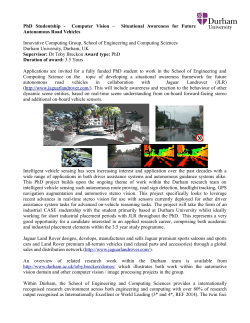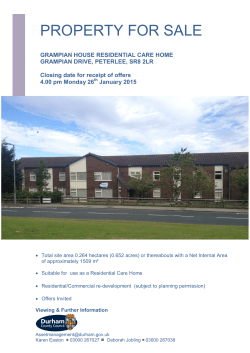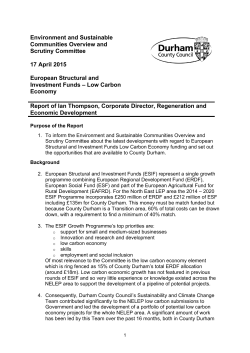
Land To Rear Of 53 Whinney Hill, Durham City, DH1 3BD PDF
Planning Services COMMITTEE REPORT APPLICATION DETAILS APPLICATION NO: 4/12/00974/FPA FULL APPLICATION DESCRIPTION: Erection of detached dwelling NAME OF APPLICANT: Mr R Hutchins ADDRESS: Land To Rear Of 53 Whinney Hill, Durham City, DH1 3BD ELECTORAL DIVISION: CASE OFFICER: Elvet And Gilesgate Steven Pilkington, Senior Planning Officer, 03000 263964, steven.pilkington@durham.gov.uk DESCRIPTION OF THE SITE AND PROPOSALS 1. The application site is located in Whinney Hill, a residential area located in the south eastern part of Durham City Conservation Area. Surrounding the application residential properties are located, including the host property of no. 53 Whinney Hill a mid-terraced dwelling which lies directly to the south east of the site. To the north the adopted highway and turning head of The Hallgarth is located and to the west a private access track serving the rear of Hallgarth Street is present. The residential gardens of 51-52 and 54 Whinney Hill are located to the south and east. The host property is located at a ground level approximately 2.8m higher than the application site, the level also falls away from the site to the adopted highway of the Hallgarth by approximately 0.5m. 2. The application seeks full planning permission for the erection of a 3 bedroomed dwelling measuring 5m in width by 7.9m in length. The pitched roof of the dwelling would measure a maximum of 6.4m to ridge height and 4.6m to eaves height. It is proposed that the property would be brick built with rendered elements, fenestration detail such a brick quoins, horizontal brick courses and flat roofed half dormers are also proposed. 3. Although sited in the rear garden of no.53 Whinney Hill the property would face out onto the residential cul-de-sac of The Hallgarth, where vehicular access would be taken off the adopted highway serving a hardstanding area. This hardstanding area would be formed on a parcel of undeveloped land currently owned by the council. 4. The application is reported to the planning committee at the request of Cllr Freeman in relation to concerns regarding the development of a greenfield site and constraints of the access. PLANNING HISTORY 5. No relevant planning history. PLANNING POLICY NATIONAL POLICY 6. The Government has consolidated all planning policy statements, guidance notes and many circulars into a single policy statement, the National Planning Policy Framework (NPPF). However, the NPPF does not change the statutory status of the development plan as the starting point for decision making. Proposed development that accords with an up-to-date Local Plan should be approved and proposed development that conflicts should be refused, unless other material considerations indicate otherwise. 7. In accordance with paragraph 215 of the National Planning Policy Framework, the weight to be attached to relevant saved local plan policy will depend upon the degree of consistency with the NPPF. The greater the consistency, the greater the weight. 8. Part 1 - Building a strong, competitive economy-. The Government is committed to securing economic growth in order to create jobs and prosperity, building on the country’s inherent strengths, and to meeting the twin challenges of global competition and of a low carbon future. 9. Part 4 – Promoting sustainable transport. Transport policies have an important role to play in facilitating sustainable development but also in contributing to wider sustainability and health objectives. The transport system needs to be balanced in favour of sustainable transport modes, giving people a real choice about how they travel. However, the Government recognises that different policies and measures will be required in different communities and opportunities to maximise sustainable transport solutions will vary from urban to rural areas. On highway safety, development should only be prevented or refused on transport grounds where the residual cumulative impacts of development are severe. 10. Part 6 - Delivering a wide choice of high quality homes. To boost significantly the supply of housing, applications should be considered in the context of the presumption in favour of sustainable development. 11. Part 7 – Requiring Good Design. The Government attaches great importance to the design of the built environment, with good design a key aspect of sustainable development, indivisible from good planning. Planning policies and decisions must aim to ensure developments; function well and add to the overall quality of an area over the lifetime of the development, establish a strong sense of place, create and sustain an appropriate mix of uses, respond to local character and history, create safe and accessible environments and be visually attractive. 12. Part 8 – Promoting Healthy Communities. The planning system can play an important role in facilitating social interaction and creating healthy, inclusive communities. Developments should be safe and accessible; Local Planning Authorities should plan positively for the provision and use of shared space and community facilities. An integrated approach to considering the location of housing, economic uses and services should be adopted. 13. Part 11 – Conserving and enhancing the natural environment. The planning system should contribute to and enhance the natural and local environment by protecting and enhancing valued landscapes, minimising impacts on biodiversity and providing net gains where possible; preventing both new and existing development from contributing to or being put at unacceptable risk from, or being adversely affected by unacceptable levels of soil, air, water or noise pollution or land instability; and remediating and mitigating despoiled, degraded, derelict, contaminated and unstable land, where appropriate. 14. Part 12 - Conserving and enhancing the historic environment. Local planning authorities should set out in their Local Plan a positive strategy for the conservation and enjoyment of the historic environment, including heritage assets most at risk through neglect, decay or other threats. In doing so, they should recognise that heritage assets are an irreplaceable resource and conserve them in a manner appropriate to their significance. NATIONAL PLANNING PRACTICE GUIDANCE: 15. The newly introduced National Planning Practice Guidance (NPPG) both supports the core government guidance set out in the NPPF, and represents detailed advice, both technical and procedural, having material weight in its own right. The advice is set out in a number of topic headings and is subject to change to reflect the up to date advice of Ministers and Government. LOCAL PLAN POLICY: 16. The following saved policies of the Durham City Local as amended by Saved and Expired Policies September 2007 are considered to be consistent with the NPPF and can therefore be given weight in the determination of this application as it is a core principle of the NPPF that decisions should be plan led. 17. Policy E5A (Open Spaces within Settlement Boundaries) Sets out that development proposals within settlement boundaries that detract from open spaces which possess important functional, visual or environmental attributes, which contribute to the settlement’s character or to the small scale character of an area, will not be permitted 18. Policy E6 (Durham City Conservation Area) Sets out the Councils aim to preserve the especial character, appearance and setting of the Durham City Conservation Area by ensuring a high quality design 19. Policy E21 (Protection of the Historic Environment) requires development proposals to minimise adverse impacts on significant features of historic interest. 20. Policy E22 (Conservation Areas) Sets out that the Authority seeks to preserve and enhance the character and appearance of the conservation area by ensuring that development proposals should be sensitive in terms of siting, scale, design and materials, where appropriate reflecting existing Architectural features. 21. Policy H2 (New Housing within Durham City) Sets out that within the development limits, new housing development will be permitted providing the development is located on previously developed land. 22. Policy H9 (Multiple Occupation/ Student Households) Sets out that the sub-division or conversion of houses to HMO’s or proposals to extend or alter HMO’s should provide adequate parking, protect the amenities of neighbouring residents, have an appropriate scale/character and will not result in concentrations of dwellings to the detriment of the range and variety of local housing stock. 23. Saved Policy H10 – Backland Development – sets out that backland development will only be permitted where a safe satisfactory means of access can be provided, the amenity of new and existing dwellings are not adversely affected and it is in keeping with the character, density and scale of surrounding developments. 24. Policy H13 (Residential Areas) seeks to protect the character, appearance and amenity of residential areas. 25. Policy Q1 (Design) Sets out that the layout and design of all new development should take into account the requirements of users including personal safety and crime prevention and the access needs of everybody including people with needs of disabilities. 26. Policy Q8 (Residential Development) Sets out the standards that new residential developments should comply with. Amongst other things, new dwellings must be appropriate in scale, form, density and materials to the character of their surroundings. The impact on the occupants of existing nearby properties should be minimised. 27. Policy U8a – (Disposal of Foul and Surface Water) – requires developments to provide satisfactory arrangements for disposing foul and surface water discharges. Where satisfactory arrangements are not available, then proposals may be approved subject to the submission of a satisfactory scheme and its implementation before the development is brought into use. 28. Policy U14 – (Energy Conservation – General) – states that the energy efficient materials and construction techniques will be encouraged. 29. Policy T1 (General Transport Policy) Requires all developments to protect highway safety and/or have significant affect on the amenity of occupiers of neighbouring properties 30. Policy T10 (Parking Provision) Seeks to limit the number of parking spaces as a property to encourage sustainable transport choices. EMERGING PLAN: 31. In considering this proposal due regard should be had to the requirements of Section 38(6) of the Planning and Compulsory Purchase Act (2004) which requires that proposals be determined in accordance with the statutory development plan, unless other material considerations indicate otherwise. In respect to this part of County Durham the statutory development plan currently comprises the ‘saved’ elements of the Durham City Local Plan that are consistent with the National Planning Policy Framework (NPPF). Due regard should also be had to relevant parts of the National Planning Policy Framework (NPPF) and national Planning Practice Guidance (PPG) as a material consideration. In conjunction with these material considerations regard should also continue to be had to the most up to date relevant evidence base. 32. Paragraph 216 of the NPPF says that decision-takers may give weight to relevant policies in emerging plans according to: the stage of the emerging plan; the extent to which there are unresolved objections to relevant policies; and, the degree of consistency of the policies in the emerging plan to the policies in the NPPF. The County Durham Plan was submitted for Examination in Public in April 2014 and stage 1 of that Examination has been concluded. However, the Inspector’s Interim Report which followed, dated 18 February 2015, has raised issues in relation to the soundness of various elements of the plan. In the light of this, policies that may be relevant to an individual scheme and which are neither the subject of significant objection nor adverse comment in the Interim Report can carry limited weight. Those policies that have been subject to significant objection can carry only very limited weight. Equally, where policy has been amended, as set out in the Interim Report, then such amended policy can carry only very limited weight. Those policies that have been the subject of adverse comment in the interim report can carry no weight in the development management process. 33. In light of the above it is considered appropriate to draw attention to the relevant components of the emerging Plan in this report to which a degree of weight can be attached. However, the weight that can be attributed to these emerging policies is of such a limited level that it should not be the overriding decisive factor in the decision making process . The above represents a summary of those policies considered most relevant in the Development Plan the full text, criteria, and justifications of each may be accessed at http://www.durham.gov.uk/ldf CONSULTATION AND PUBLICITY RESPONSES STATUTORY RESPONSES: 34. Highway Authority – Following amended plans offers no objections to the scheme, it is however highlighted that a 0.5m service strip should be maintained from the edge of the carriageway and that boundary treatments to the front should not exceed 1m in height. 35. Northumbrian Water Limited – Highlight the proximity of a sewer to the proposed dwelling which would be required to be diverted in order to accommodate the development. INTERNAL CONSULTEE RESPONSES: 36. Design and Conservation – Advise that a new dwelling in the proposed location would not compromise the special qualities or the setting of the conservation area due to the limited visibility and lack of interaction. However it is considered that the dwelling fails to respond to the character of the immediate area in terms of its scale, massing and fenestration detailing and would therefore have an inappropriate impact. 37. Ecology Section – Raise no objections. PUBLIC RESPONSES: 38. The application has been publicised by way of press and site notice, and individual notification letters to neighbouring residents. 11 objections have been received from neighbouring residents including responses from the City Of Durham Trust and Whinney Hill Community Group relating to the following issues:- Potential use of the dwelling by students and associated resultant noise and disturbance, loss of housing for residents and over population by students. It is highlighted that the host property has been turned into accommodation for students while concerns are raised regarding the cumulative impact of the development - Objections are raised on the basis that the proposal would represent development on a Greenfield Site, and therefore conflict with the Local Plan. - The design does not reference that of surrounding dwellings and is not in keeping. The proposal will not preserve or enhance the conservation area, concerns are also raised about loss of trees and hedgerows which form the character of the area - It is highlighted the policy requirement to encourage the orientation of dwellings to maximise the principles of energy conservation. - Concerns are raised regarding the loss of natural drainage from the garden and restriction of overland flow in heavy rain events. It is unclear how the sewer will be diverted and the implications of this. - Development of the site will involve council owned land - The development will contribute to parking pressures and traffic in the area and the local road infrastructure is inadequate, while there are potential restrictions on access for users of the lane to the west of the dwelling. - The proposal will impact on the privacy and amenity of neighbouring residents due to inadequate separation distances. - Concerns are raised regarding the lack of publicity of the planning application and anomalies in the planning application particularly the application forms. - The presence of potential restrictive covenants placed on the land is raised. APPLICANTS STATEMENT: 39. The proposal is to provide a modest family dwelling on the irregular shaped rear garden of no 53 Whinney Hill. On plan the dwelling sits without affecting the surrounding properties and still retains adequate garden space for no 53. The dwelling is accessible from the existing highway infrastructure and connections to all public utilities are readily available and therefore the scheme satisfies all the criteria of sustainability. 40. The design is influenced by the adjacent post war public housing with rendered and facing brick walls and tiled roof. The topography of the area determines the floor level as sitting much lower than the Whinney Hill housing, therefore minimising any impact. The proposal provides an addition to the housing stock for family use without any loss of public space or amenity of surrounding properties. The above represents a summary of the comments received on this application. The full written text is available for inspection on the application file which can be viewed at: http://publicaccess.durham.gov.uk/onlineapplications/applicationDetails.do?activeTab=summary&keyVal=MCCK8ABN5B000 PLANNING CONSIDERATIONS AND ASSESSMENT 41. Having regard to the requirements of Section 38(6) of the Planning and Compulsory Purchase Act 2004, the relevant Development Plan policies, relevant guidance and all other material planning considerations, including representations received, it is considered that the main planning issues raised relate to the principle of development, effect on the character and appearance of the conservation area, residential amenity, and highway safety. These matters are addressed in turn below. The Principle of Development 42. The application site is located within the settlement limits of Durham City, as defined by the Durham City Local Plan Proposals Map. Saved Policy H2 of the Local Plan sets out that small scale residential developments will be acceptable within these settlement limits providing the site is classed as previously developed land. 43. In accordance with paragraph 215 of the National Planning Policy Framework, the weight to be attached to relevant saved local plan policies will depend upon the degree of consistency with the NPPF. The greater the consistency, the greater the weight. In this respect it is considered that the general approach of Policy H2 in terms of directing development to settlements best able to support it is consistent with the NPPF and the promotion of sustainable patterns of development. While the NPPF does promote the use of previously developed land there has been a shift to an assessment of the overall sustainability of a site, and the development of greenfield sites, including garden curtilages, is not precluded. 44. In assessing the sustainability of the site, it is considered that it performs particularly well, being located within walking distance of the services, amenities and employment sites of the Durham City Centre while being in close proximity to public transport networks. Future residents would therefore have ready access to these facilities without the need to utilise the private motor car. 45. In addition to sustainability objectives, the NPPF sets out that development should provide a range of housing types and sizes responding to the needs of all members of the community, including ensuring that there is a mix and range of housing available for different members of the community. Objections around this issue have been raised, highlighting that although the applicant states that the property would be for family housing it would likely be occupied by students. Objectors consider that this would have a cumulative adverse impact given the amount of other student accommodation which is considered to negatively impact on the amenities or residents and reduces the availability of family housing. Notwithstanding the applicant’s statement given the proximity of other student accommodation, it is considered possible that the proposed dwelling could be used to provide student accommodation, either immediately or in the future. This is because planning permission is not required to change of use from a C3 dwelling house to a small scale HMO (Uses class C4) or vice-versa similar to the existing housing stock in the area. 46. Saved Policy H9 of the Local Plan seeks to address this issue aiming to restrict concentrations of student households to preserve the range and variety of local housing stock and to ensure that a particular type of housing is not reduced to an unacceptable extent, policy H13 also seeks to protect the character of residential areas. In appraising the application against this policy, it is recognised that there are significant concentrations of student populations in the immediate area which is interspersed by family properties. However the proposed development is for a small new built dwelling consisting of two standard sized bedrooms and a third ‘box’ room. Given the likely level of occupation, even potentially by students, the proposal is considered to have a negligible impact on student populations in the area, particularly as planning permission is not required to provide student accommodation in existing housing stock up to a specified level. The limited size of the building and accommodation potential would mean that the yields generated from letting to students would likely be similar to that of normal market rentals making it more affordable for families should the property be marketed. 47. The wider matter of student accommodation is also referenced within emerging County Durham Plan, through policy 32 which sought to limit concentrations of student populations. This was subject to a proposed main examination hearing change at the Examination in Public. However, the Policy and proposed change were explicitly found to be unsound by the Inspector’s Interim Report. On this basis, Policy 32 cannot be given any weight. Although the inspector suggested different wording this also holds no weight in decision making as it has not been considered by the Council and it has not been subject to consultation or sustainability appraisal. 48. Overall it is considered that the proposed development is located in a sustainable location and would not impact on the range of housing available within the wider area. Although part of the dwelling would represent development on a Greenfield Site, in conflict with saved policy H2, in principle the location of the proposed residential development is acceptable, following appraisal against relevant national policies. This is because only limited weight can be attached to saved policy H2 given that it is not consistent with the more up to date policy contained within NPPF Design, layout and the effect on the character of the area 49. Local Plan Policies E6, E21 and E22 seek to preserve the historic environment, particularly the character and appearance of Conservation Areas. These policies reflect the requirements of Section 72 of the Planning (Listed Buildings and Conservation Areas) Act 1990 in terms of having special regard to the desirability of preserving the special character and appearance of conservation areas. The NPPF also seeks to conserve or enhance heritage assets in a manner appropriate to their significance. In this instance the Heritage asset can be identified as the Durham City Conservation Area. 50. In assessing the impact of the development on the character and appearance of the Durham City Conservation Area the Councils Design and Conservation Section identify that the development site is essentially set between two distinct areas, Whinney Hill and Hallgarth Street. In terms of Whinney Hill’s historic interest, it is an example of the City's period of planned expansion during the early 20th century. The plan form and the architectural character of the interwar semi-detached houses here are typical of the design of social housing at the time. Whereas Hallgarth Street’s interest can be summarised as maintaining a relatively simple plan form and layout informed by the original medieval substructure and retaining its domestic character. In taking into account the special qualities of these two areas it is advised by the councils Design and Conservation Section that a new dwelling in the proposed location would not compromise the special qualities or the setting of the Conservation Area due to a lack of inter-visibility and interaction. Essentially the development would only impact at a localised level more within the context of a modern area. 51. In terms of the design of the property the Design and Conservation Section highlight that the surrounding housing stock in Whinney Hill has a distinctive character, where houses conform to a regular pattern, size and material palette principally with hipped overhanging pan tiled roofs. It is noted that properties in Whinney Hill do vary but the general characteristics include moderately wider foot prints, hipped roof, curved bays and windows set below the eaves. It is advised that the proposed dwelling displays insufficient characteristics of this local vernacular and along with contemporary elements would generate a new building which would be out of keeping with its surroundings. 52. In considering the proposal against the above policy context and comments raised by the Councils Design and Conservation Section, it is appreciated that the dwellings of Whinney Hill do have a distinctive character, defined by the regularity of the style of the dwellings and materials used. However the application site is located in what is considered to be a transition area between three distinctive areas within this part of the conservation area, namely Whinney Hill, Hallgarth Street and thirdly the dwellings that line The Hallgarth. Although the property is seen against the backdrop of the rear elevations of Whinney Hill it is not seen in the wider context of the Whinney Hill street scene, fronting out onto Hallgarth Street. The character of Hallgarth Street is defined by flatted properties built in the 1970’s, brick built with pitched roofs. The architectural quality of these properties is considered to be significantly less than that of Whinney Hill and Hallgarth Street. While acknowledging the views of the Design and Conservation Section, given the location of the proposed dwelling, is considered appropriate that the property would take design cues from both streets and on this basis the design of the property is considered acceptable particularly considering the limited interaction with the wider Winney Hill street scene and more sensitive areas of the Conservation Area. The finer detailing of the dwelling, including materials used and window detailing is recommended to be controlled by condition, to ensure an appropriate match with surrounding properties. 53. The formation of the proposed hardstanding will required the removal of a small grassed area currently owned by the council. This parcel of land is considered to offer little to the street scene and the formation of a hardstanding would be similar to the vehicular access to the rear of no. 54 Winney Hill. No significant trees or vegetation would be removed to facilitate the development. 54. Overall it is considered that the siting and design of the dwelling would have an acceptable impact on the character of the surrounding area and would not impact on the wider character and appearance of the Conservation Area in accordance with policies E6, E21 and E22 of the Local Plan and section 12 of the NPPF. The proposal would therefore satisfy Section 72 of the Planning (Listed Buildings and Conservation Areas) Act 1990 in this respect, as it is considered to preserve the character and appearance of the Conservation Area. Residential Amenity 55. Policy Q8 of the Local Plan requires new residential developments to protect the amenities of adjacent land users by setting out a number of guideline separation distances. This includes a 21m buffer between windows of habitable rooms, 13m between a habitable room window and a two storey gable. 56. The proposed development would be sited at an approximate 45 degree angle to the rear elevations of the terrace of 51-54 Whinney Hill. A distance of 10.8m would be evident to the rear elevation of the nearest property of no.54 Whinney Hill and the corner of the rear elevation of the proposed dwelling. Although this distance falls below the guideline distance of 13m, given the drop in levels to the application site (approx. 2.8m to its most extreme point) and the orientation of the proposed dwelling this is considered acceptable and would not compromise amenity standards. Views back towards 51-54 Whinney Hill would be at a tight obscure angle, again due to the orientation of the dwellings. This angle would lessen towards no’s.51-52, however a separation distance of approximately 21.5m would be evident in line with policy guidance. 57. To the front of the proposed dwelling the properties of 30-36 The Hallgarth are located. A separation distance of approximately 19.5m would be evident between the front elevation of the proposal and the frontage of these properties. Although again this would fall below the minimum recommended 21m separation distance between habitable room windows this is considered acceptable given the public frontages of these properties. In addition, the proposed dwelling does not occupy a direct face to face relationship, being partially offset from the end property of the facing block. 58. The amenity space of the proposed dwelling, consisting of a rear and side garden and hardstanding driveway would measure approximately 105m2. Although limited in size, this space is considered sufficient to serve this modest dwelling. Although these outdoor spaces would be directly overlooked there would be the opportunity to form private areas due to the level changes on site and likely boundary treatments. Sufficient space would be provided for bin storage and off street car parking for two vehicles. 59. Objections have been received regarding potential noise generated from the development as it has the potential to be occupied by students. Policy H9 of the Local Plan sets out that conversion or extension of properties for student accommodation/HMO’s will only be permitted where they protect the amenity of neighbouring residents and there is adequate amenity areas provided at the property. The policy clarifies this by stating that adverse effects on the amenities of other occupants include noise disturbance and infringement of privacy. Although this policy does not directly relate to new builds, it is considered relevant given the use of the host property and the possible occupants of the dwelling. However as highlighted above, this is a small property and even if occupied by students, the number of occupants would be limited, while being set away from existing dwellings, and this is not considered a sufficient reason to refuse the planning application. 60. The Council’s Environmental Health Section has recommended conditions relating to working hours and construction activities. However, these construction related effects are matters which the planning system cannot reasonably prevent or control and there are controls outside of planning that deal with noise nuisance and other disturbance, which would be more appropriate controls than planning conditions. Therefore, there is no precise justification for such conditions in this instance, particularly given the scale of development proposed. 61. Overall it is considered that the proposed development would have an impact on the levels of privacy and amenity experienced by neighbouring developments. However this is not considered to adversely affect the amenity of neighbouring residents nor prospective occupants of the new dwelling to a degree that should lead to refusal of planning permission. It is therefore considered that the proposal complies with policies H9, H13 and Q8 of the Durham City Local Plan in this respect. It is however recommended to remove permitted development rights for extensions and future alterations given the constraints of the site. Access and highway safety issues 62. Saved policies H10, Q8 and T1 of the Durham City Local Plan require that all developments protect highway safety and provide sufficient off street car parking. As part of the consideration of this application, a consultation exercise has been held with the Council’s Highway Section, who offers no objections to the scheme. This is on the basis of an appropriate level of off street car parking (2 spaces) and the sufficient manoeuvring on the highway to access the dwelling. 63. Concerns have been raised from local residents regarding the potential restriction of an access way to the west of the site. This access way is utilised by residents under a private agreement with the Council and which serves a number of garages and accesses to the rear of Hallgarth Street. However the proposed development will not encroach onto this access track and sufficient manoeuvring will still be achievable to access garages without encroaching onto the applicants land. The council as the owner of this access way has the ability to enforce against any blockage, however it is considered unlikely that this development would encourage the blocking of this access given the level of car parking proposed on site. 64. It is therefore considered that the scale of development and proposed use of the vehicular access would not have an adverse impact on highway safety or local highway capacity. This accords with Durham City Local Plan saved policies H10, Q8 and T1. On the advice of the highways officer it is however recommended to remove permitted development rights for fences, to ensure satisfactory visibility. A condition requiring the implementation of the hard standing space is also recommended. Other issues 65. Paragraph 11 of the NPPF and policy E16 of the Local Plan requires Local Planning Authorities to take into account, protect and mitigate the effects of development on Biodiversity Interests. In this instance given the cleared nature of the site, it is considered unlikely that the granting of planning permission would constitute a breach of the Conservation Habitats, & Species Regulations 2010 (as amended) as advised by the Ecology Section. 66. As advised by Northumbrian Water a sewer crosses part of the application site which would need to be diverted in order to accommodate the development. Significant negotiations have been held between the applicant and Northumbrian Water and in principle this has been agreed. It is not considered necessary, given Northumbrian Waters statutory function, to control this through the planning system. It is however recommended to attach a condition to require full details of foul and surface water disposal, to utilise sustainable drainage where appropriate. 67. Concerns have been raised by residents regarding the potential for the development to impact on localised surface water flooding which is advised that in extreme events flows down the private lane to the west. However the application site sits slightly higher than the lane and is therefore not considered to impede any flows, while surface water runoff from the development will either be directed to mains drainage or sustainable drainage where appropriate. It is therefore recommended, as indicated above, attaching a condition to require full details of foul and surface water disposal to be submitted to and agreed before the development commences. 68. Objections have been raised regarding the potential for restrictive covenants on the land, however this is not a material planning consideration and the developer would need to satisfy themselves that they have the legal right to carry out the development. CONCLUSION 69. The proposed scheme has been considered against the policy documents identified above. The principle of the development is considered acceptable being located within the settlement limits of the City of Durham, in a sustainable location. The scale and location of the development is not considered to have a significant increase on the student population in the area. 70. The scheme is considered appropriate in terms of impact upon the Durham City Centre Conservation Area as the development would not be seen in the wider context of the Conservation Area and its appearance is considered appropriate in relation to existing housing stock. 71. Although the development would have a degree of impact on the amenity and privacy of surrounding developments, this impact is not considered to be significant in this instance to warrant refusal of the scheme. 72. The development would not have an adverse impact on highway safety or any ecology interests. There are no material planning considerations which indicate a decision should be otherwise, and therefore the application is recommended for approval RECOMMENDATION That the application be APPROVED subject to the following conditions:1. The development hereby permitted shall be begun before the expiration of three years from the date of this permission. Reason – required to be imposed pursuant to section 91 of the Town and Country Planning Act 1990 as amended by the Planning and Compulsory Purchase Act 2004. 2. The development hereby approved shall be carried out in strict accordance with the following approved plans Proposed Elevations and Floor Plans, Ref 12 40 02 E, Received 25th February 2015 Proposed Site Plan, Ref 12 40 03 C, Received 25th February 2015 Proposed Elevations Sections, Ref 12 40 04, Received 25th February 2015 Reason – To define the consent and ensure that a satisfactory form of development is obtained in accordance with policies E6, E21, E22, , H2, H9, Q1, Q8, T1, T10 of the Durham City Local Plan 3. Notwithstanding any details of materials submitted with the application, no development shall commence until details of all materials to be used externally have been submitted to and approved in writing by the Local Planning Authority. The development shall be constructed in accordance with the approved details thereafter. Reason: To ensure that a satisfactory form of development is obtained in the interests of visual amenity of the Durham City Conservation Area accordance with the provisions of policies E6, E21, E22 and Q8 of the Durham City Local Plan. 4. Notwithstanding the submitted information, details (including cross-sections), materials and colour of all windows, (including dormer windows) shall be submitted to and approved in writing by the Local Planning Authority before the development hereby approved commences. The development shall be carried out in accordance with the approved details thereafter. Reason: To ensure that a satisfactory form of development is obtained in the interests of visual amenity of the Durham City Conservation Area accordance with the provisions of policies E6, E21, E22 and Q8 of the Durham City Local Plan. 5. Notwithstanding the provisions of Class A,B, D and E of Part 1, Schedule 2 of the Town and Country Planning (General Permitted Development) Order 2015 (or any Order revoking or re-enacting that Order) details of any enlargement, improvement or other alteration to the dwelling hereby approved shall be submitted to and approved by the Local Planning Authority. Reason: To ensure that a satisfactory form of development is obtained in the interests of visual amenity of the Durham City Conservation Area and to protect the amenities of neighbouring residents in accordance with the provisions of policies E6, E21, E22 and Q8 of the Durham City Local Plan. 6. Notwithstanding the provisions of Class A, of Part 2 Schedule 2 of the Town and Country Planning (General Permitted Development) Order 2015 (or any Order revoking or re-enacting that Order) no fence or means of enclosure shall be erected forward of any wall of the dwelling hereby approved fronting onto a highway. Reason: To ensure that a satisfactory form of development is obtained in the interests of visual amenity of the Durham City Conservation Area and to ensure satisfactory visibility in the interests of highway safety in accordance with the provisions of policies E6, E21, E22, Q8 and T1 of the Durham City Local Plan 7. Notwithstanding the submitted information full details including the materials to be used and construction details of the proposed vehicle hard standing shall be submitted to and approved in writing by the Local Planning Authority. The hardstanding stall be implemented in accordance with the approved details and brought into use prior to the first occupation of the dwelling. Reason: To ensure that a satisfactory form of development is obtained in the interests of visual amenity of the Durham City Conservation Area and to ensure satisfactory in curtilage car parking in the interests of highway safety in accordance with the provisions of policies E6, E21, E22, Q8 and T1 of the Durham City Local Plan 8. No development approved by this permission other than preliminary site excavation shall commence until a detailed scheme for the disposal of foul and surface water has been submitted to and approved in writing by the Local Planning Authority. The development shall be carried out and implemented in accordance with the approved scheme thereafter. Reason: to ensure a satisfactory means of drainage for foul and surface water in accordance with policy U8a of the Durham City Local Plan. STATEMENT OF PROACTIVE ENGAGEMENT 65. In arriving at the recommendation to approve the application the Local Planning Authority has assessed the proposal against the NPPF and the Development Plan in the most efficient way to ensure a positive outcome through appropriate and proportionate engagement with the applicant, and carefully weighing up the representations received to deliver an acceptable development. BACKGROUND PAPERS Submitted Application Forms, Plans and supporting documentation Durham City Local Plan National Planning Policy Framework Consultation responses County Durham Local Plan Submission Version Application 4/12/00974/FPA Proposed Access Location Application Site Erection of 1no. Detached Dwelling Planning Services This map is based upon Ordnance Survey material with the permission o Ordnance Survey on behalf of Her majesty’s Stationary Office © Crown copyright. Unauthorised reproduction infringes Crown copyright and may lead to prosecution or civil proceeding. Durham County Council Licence No. 100022202 2005 Comments Date 27th April 2015 Scale 1:2500
© Copyright 2025









